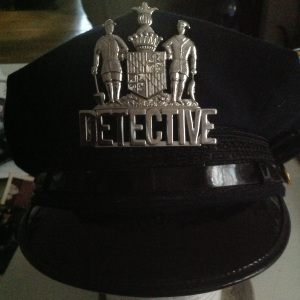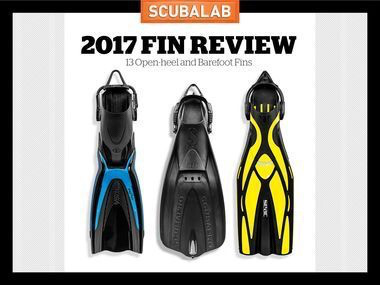 How We Test
We tested scuba fins at Alexander Springs Recreation Area in central Florida. Testers used underwater slates to record comments and rate each fin from 5 (excellent) to 1 (poor) in a number of categories including ease of donning and doffing, comfort, stability and maneuverability.
Open-Heel Scuba Diving Fins
Tusa Hyflex Switch
How We Test
We tested scuba fins at Alexander Springs Recreation Area in central Florida. Testers used underwater slates to record comments and rate each fin from 5 (excellent) to 1 (poor) in a number of categories including ease of donning and doffing, comfort, stability and maneuverability.
Open-Heel Scuba Diving Fins
Tusa Hyflex Switch
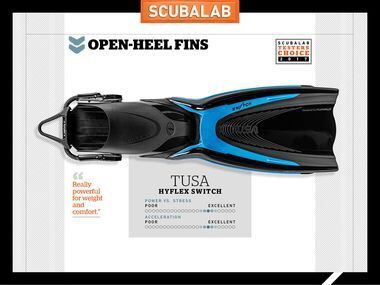
Test divers thought the new HyFlex fin might be too flexible — until they got it in the water. Just 23½ inches long, it has a blade set at a 20-degree angle with a series of ripples along the bottom designed to reduce drag. “Flutter kick effortless, with good speed” and “great power, easy on legs,” were typical comments. The easy kicking was aided by a foot pocket rated the most comfortable in the test, in part because of the bungee-strap system with five adjustment positions that can be changed without tools. The bungee was rated excellent for donning and doffing, and the blade unbolts from the foot pocket for a travel package that’s less than 16 inches long. Selected as the favorite by more divers than any other fin in our test, the Tusa HyFlex Switch is our Testers Choice.
Apeks RK3 HD
This new version of Apeks’ RK3 fin is made from a denser, negatively buoyant material. Like the original RK3, its DNA can be traced to some of the first vented-rubber scuba diving fins. Its tec orientation is clear, and to be fair, that put it at a disadvantage in our more rec-oriented evaluation. But despite that — and its stubby appearance (19 inches) — it notched performance scores at the top. Scuba divers rated it very good for power vs. stress, acceleration and maneuverability. Fittingly, given its froglike appearance, it took top score for efficiency in frog style. The flutter, especially at speed, was a little more work given the fin’s weight (2½ pounds each), but still rated very good. Though on the boxy side, the foot pockets provide good support, and the fin earned very good scores for comfort and stability.
Dacor Mariner
With a bit of a blast-from-the-past look, the Mariner was the only fin in our test not equipped with bungee or spring straps, and these days that’s like a teenager on vacation with no Internet. But here’s the thing: Get past all the “What, no Internet?” gripes, and the Dacor Mariner held its own against a lineup of much-pricier footwear. Yes, the strap is so 2008, but the soft, supportive foot pocket scored as high for comfort as any scuba fin here. And with its longish vented blade (25 inches) with modest and not especially progressive flex, the Mariner could still cover some ground, earning very good scores for efficiency in flutter and alternate kicking styles and acceleration. The Mariner also won praise from test divers including “nice all-around fin” and “solid performance.”
Deep Six EddyThe Eddy has the look of a traditional jet fin but with a different feel, made of a stiffer, lighter polymer (2¼ pounds in size large) — except for the smallest size, which is made of a more flexible material. The foot pocket also is curved along the top and toes, and has a longer foot bed to better support soft-soled boots. Those features helped it score well in our rec-oriented evaluation, with scuba divers rating the fin very good for comfort and stability. The Deep Six Eddy also was rated very good for maneuverability and for efficiency in the frog kick, where it excelled. “Very responsive to frog kick,” commented one test diver. It takes a little work to keep the long blades (21 inches in size large) moving fast in a flutter, but divers rated it good for efficiency and acceleration.
Mares XR Power Plana Tec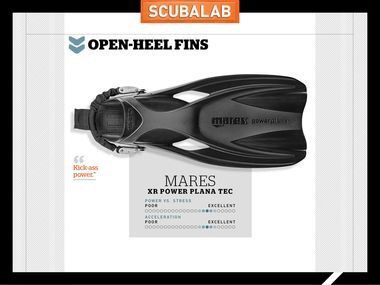
Weighing 3½ pounds each (size regular), with a design that looks inspired by prehistoric sea monsters, this new stainless spring-strap tec version of the Power Plana is more badass than ever. “The Rock would buy these fins,” wrote one diver, and indeed, they don’t look fit for the faint-hearted. But they proved to be surprisingly manageable, earning very good scores for stability, power vs. stress, acceleration, maneuverability and efficiency in flutter and frog kick. Content to cruise along, they’re also capable of churning up a wake if you have the legs to keep those big blades pumping. As one test diver noted, “These paddles move a lot of water.” A foot pocket that’s made for drysuit boots didn’t help its comfort scores, but the Mares Power Plana impressed with its stability and efficiency.
Oceanic Manta Ray

The Manta Ray’s design was inspired by the fins of marine animals, and you can see the resemblance. It isn’t especially long (23½ inches), but the blade is relatively wide and has a large, soft center channel flanked by stiff side sections. The Oceanic Manta Ray’s efficiency scores put it in about the center, but individual divers split higher or lower; those with a preference for stiffer blades with a big bite scored it high, while those who like more flex tended lower. The foot pocket is rigid and a bit boxy; scuba divers with wide feet and heavy-soled boots found it supportive and comfortable, while those with thinner boots found it less so. The fit was helped by the clever adjusters in the buckles that allow about an inch of movement in the spring strap on each side without tools.
Seac F1S

The F1S fin is 25 inches long (size medium-large) with a robust foot pocket and broad, square-tipped blade, so we were surprised it weighed just 1½ pounds. The design, with rigid sections in the blade connected by a web of rubbery elastomer, creates a soft tip that stiffens toward the toes. The result was power without leg fatigue, helped by a comfortable foot pocket and bungee strap. “Good return on muscle investment,” wrote one diver, and testers rewarded the Seac fin with very high scores for efficiency in the flutter kick and very good scores for power vs. stress and for stability. It also showed good acceleration, especially if you let those big blades work up to speed a bit gradually. With performance and comfort at an attractive price, the Seac F1S is our Best Buy.
XS Scuba Recoil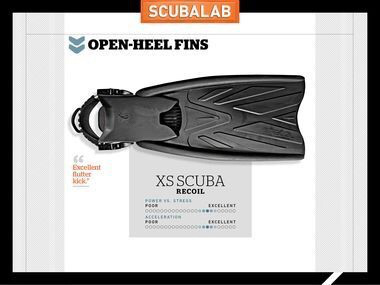
The unique feature of the XS Scuba Recoil fin is the pair of short springs on the bottom of the side rails. They stretch on the upstroke to let the blade flex, but bottom out on the downstroke when the blade reaches about 45 degrees to the foot pocket, pushing lots of water with the soft blade channel. A comfortable foot pocket and secure spring strap let you kick hard with comfort; the result was the highest score in our test for efficiency in the flutter kick, and a very good score for acceleration. Made of dense thermoplastic rubber, the Recoil weighs 3½ pounds each in size medium. A few divers noted a slight click with each kick — not annoying, but unusual. The Recoil scored good for frog kick and maneuvering, areas where some divers felt the springs worked against it.
Full-Foot Scuba FinsCressi Aqua

The Cressi Agua stiffens the rear of the otherwise very flexible blade with two buttresses on the bottom near the toes. We were able to try the Agua in only three of the six available sizes, but scuba divers who found a size that worked well rated it good for comfort. The comfortable foot pocket and the fin’s light weight (less than 1 pound each in size 10-11) let you kick long and hard without fatigue. That’s good, because the soft blade requires steady kicking to work up and maintain speed. Some divers found the Agua a little too soft for a scuba diver with the drag of a BC and other gear. But its lightweight, low-stress design, comfortable foot pocket and very good surface kicking performance make the Agua an attractively priced option for a snorkel fin.
Scubapro Go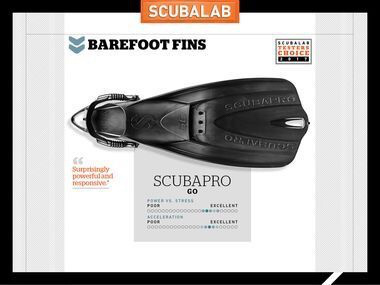
Aimed at travelers, the Scubapro GO is just a little over 1¼ pounds each and 20½ inches long in size medium-large, with a nifty clip on the blade to bungee them together. That makes it great for packing, but it’s even better in the water. The short blade is wide and set at a steep 25-degree angle to the foot pocket, with deep rails and ridges. That lets it work like a bigger fin, earning very good scores for kicking in flutter, frog and alternate styles, and for acceleration. “Kicked like a much larger fin” was a typical test-diver comment. Rated good for comfort, the GO is available in five sizes from 3XS to XL. It seemed sized a little small to us, though it fit all of our testers except those with the largest feet. Efficient and powerful, the Scubapro GO is our Testers Choice for barefoot fins.
Share this:


